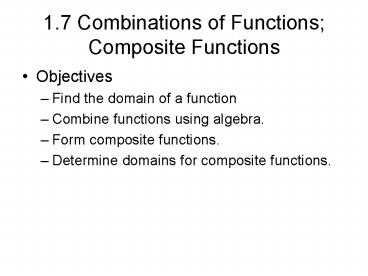1'7 Combinations of Functions Composite Functions - PowerPoint PPT Presentation
1 / 23
Title:
1'7 Combinations of Functions Composite Functions
Description:
Combine functions using algebra. Form composite functions. ... f(1) and f(5), for. f(1) = Since f(1) is defined, 1 is in the domain of f. f(5) ... – PowerPoint PPT presentation
Number of Views:61
Avg rating:3.0/5.0
Title: 1'7 Combinations of Functions Composite Functions
1
1.7 Combinations of FunctionsComposite Functions
- Objectives
- Find the domain of a function
- Combine functions using algebra.
- Form composite functions.
- Determine domains for composite functions.
2
- Find the indicated function values and determine
whether the given values are in the domain of the
function. - f(1) and f(5), for
- f(1)
- Since f(1) is defined, 1 is in the domain of f.
- f(5)
- Since division by 0 is not defined, the number 5
is not in the domain of f.
3
- Find the domain of the function
- Solution
- We can substitute any real number in the
numerator, but we must avoid inputs that make the
denominator 0. - Solve x2 ? 3x ? 28 0.
- (x ? 7)(x 4) 0
- x ? 7 0 or x 4 0
- x 7 or x ?4
- The domain consists of the set of all real
numbers except ?4 and 7 or xx ? ?4 and x ? 7.
4
To find the domain of a function that has a
variable in the denominator, set the denominator
equal to zero and solve the equation. All
solutions to that equation are then removed from
consideration for the domain.
5
Find the domain
- Since the radical is defined only for values that
are greater than or equal to zero, solve the
inequality
6
Visualizing Domain and Range
- Keep the following in mind regarding the graph of
a function - Domain the set of a functions inputs, found
on the x-axis (horizontal). - Range the set of a functions outputs, found
on the y-axis (vertical).
7
Example
- Graph the function. Then estimate the domain and
range. - Domain 1, ?)
- Range 0, ?)
8
The domain of a function is normally all real
numbers but there are some exceptions
- A) You can not divide by zero.
- Any values that would result in a zero
denominator are NOT allowed, therefore the domain
of the function (possible x values) would be
limited. - B) You can not take the square root (or any even
root) of a negative number. - Any values that would result in negatives under
an even radical (such as square roots) result in
a domain restriction.
9
Example
- Find the domain
- There are xs under an even radical AND xs in
the denominator, so we must consider both of
these as possible limitations to our domain.
10
(No Transcript)
11
(No Transcript)
12
(No Transcript)
13
(No Transcript)
14
Example
- Given that f(x) x 2 and g(x) 2x 5, find
each of the following. - a) (f g)(x) b) (f g)(5)
- Solution
- a)
b) We can find (f g)(5) provided 5 is in the
domain of each function. This is true. f(5) 5
2 7 g(5) 2(5) 5 15
(f g)(5) f(5) g(5) 7 15 22 or
(f g)(5) 3(5) 7 22
15
Example
- Given that f(x) x 2 and g(x) 2x 5, find
each of the following. - a) (f - g)(x) b) (f - g)(5)
- Solution
- a)
b) We can find (f - g)(5) provided 5 is in the
domain of each function. This is true. f(5) 5
2 7 g(5) 2(5) 5 15
(f - g)(5) f(5) - g(5) 7 - 15 -8 or
(f - g)(5) -(5) - 3 -8
16
Example
- Given that f(x) x 2 and g(x) 2x 5, find
each of the following. - a) (f g)(x) b) (f g)(5)
- Solution
- a)
b) We can find (f g)(5) provided 5 is in the
domain of each function. This is true. f(5) 5
2 7 g(5) 2(5) 5 15
(f g)(5) f(5)g(5) 7 (15) 105 or
(f g)(5) 2(25) 9(5) 10 105
17
Given the functions below, find and give the
domain.
The radicand x 3 cannot be negative. Solving
gives
18
Composition of functions
- Composition of functions means the output from
the inner function becomes the input of the outer
function. - f(g(3)) means you evaluate function g at x3,
then plug that value into function f in place of
the x. - Notation for composition
19
Given two functions
f
and
g
, the
composite function
, denoted by
(read as
f
composed with
g
), is defined by
The domain of
is the set of
x
all numbers
in the domain of
g
(
g
such that
x
) is in the domain
of
f
.
20
Suppose
and
. Find
.
21
. Find
Suppose
and
the domain of
.
22
Suppose that andfind
23
Suppose that andfind































